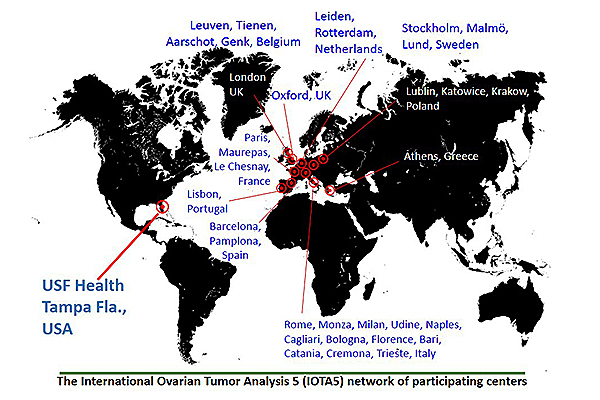USF Health is only U.S. site participating in the International Ovarian Tumor Analysis phase 5 study
A watchful waiting approach may be better than surgery for most women whose ovarian cysts are initially classified as benign (non-cancerous) by ultrasound imaging, according to the two-year interim results of the International Ovarian Tumor Analysis phase 5 (IOTA5) study.
Published Feb. 5 in Lancet Oncology, the IOTA study’s interim analysis found that women who were managed conservatively had a low risk for subsequent malignancy or severe complications requiring surgery to remove the cyst or entire ovary.
The USF Health Morsani College of Medicine is the only U.S site for this large-scale prospective study, which initially recruited more than 8,519 patients with at least one ovarian tumor (growth) from 36 centers in 14 countries. The interim study analyzed complete data for nearly 2,000 women conservatively managed in the two years after an ovarian cyst was initially categorized as benign. The management included routine ultrasound scans and clinical follow-up at three months, six months, and every 12 months thereafter.

Lauri Hochberg, MD, director of the USF Health Gynecologic Imaging Service, leads the IOTA5 study site in Tampa, Fla.
The USF Health site monitored 52 patients from West Central Florida who met the study criteria and returned for ultrasound follow-up.
“With an international study of this size, we hope to have enough patients to answer the question ‘how often do these ovarian cysts judged to be noncancerous with ultrasound protocol actually turn into cancer?’” said study coauthor Lauri Hochberg, MD, assistant professor of obstetrics and gynecology and director of the Gynecologic Imaging Service, USF Health Morsani College of Medicine. “So far, we are finding that it is safe to follow these benign-appearing masses conservatively and avoid surgery.”
Ovarian cysts, fluid-filled sacs in an ovary or on its surface, are always surgically removed when cancer is suspected — yet many physicians continue to recommend precautionary surgery to remove almost all ovarian cysts and tumors (solid masses). They cite as concerns the possibility of a benign growth transforming into cancer, the risk of serious complications such as the cysts rupturing or causing the ovaries to twist, or misclassification of the cyst as benign by the initial ultrasound scan.
In fact, Dr. Hochberg said, surgery to remove a benign cyst causing no bothersome symptoms, such as severe bloating or pelvic pain, is likely to cause more problems than the growth itself.
The two-year interim analysis of conservatively managed patients meeting study protocol found:
- In 20% of cases, the cysts judged to be benign eventually disappeared naturally.
- While 15% of the women eventually underwent surgery for new masses on follow-up, only 7 out of 1,919 were diagnosed with invasive ovarian cancer for a two-year cumulative risk of less than 0.4%. That may have been because their tumors were originally misdiagnosed as benign by ultrasound, the researchers say.
- The risk of incurring ovarian twisting was 0.4%, and the likelihood of cyst rupture 0.2%. In contrast, the frequency of severe short-term surgical complications from removing ovaries ranges from 3.5% to as high as 15%, and long-term surgical complications of abnormal scarring can cause bowel obstruction, chronic pelvic pain or fertility problems
The results thus far “could be of great value when counseling women patients and supports the conservative management of adnexal masses (ovarian cysts and tumors) that are classified as benign by the use of ultrasound,” the authors conclude. “This information could lead to a reduction in the number of women who undergo surgery for benign adnexal pathology.”

Ultrasound image of an ovarian tumor proven to be cancerous by pathologic exam after it was surgically removed.
The IOTA5 study is expected to continue through 2020, until each conservatively managed patient has been followed up for at least five years. The research is led by University Hospitals Leuven in Belgium, which continues to refine predication models using ultrasound to assess whether pelvic masses are benign or cancerous.
Researchers still need to determine how long and at what intervals ovarian cysts and masses diagnosed as benign should be optimally monitored by ultrasound, said USF Health’s Dr. Hochberg, an expert in gynecologic sonography.
“But, it’s exciting to know that (conservative management) is being proven safe by the data,” she said. “The women we are continuing to monitor with ultrasound have been happy to avoid surgery, and feel reassured that if the mass got much bigger or anything looked suspicious we would proceed to remove the cyst.”
USF Health’s gynecology imaging service is one of few practices across Florida certified in 3D gynecologic ultrasound by the American Institute of Ultrasound in Medicine.


